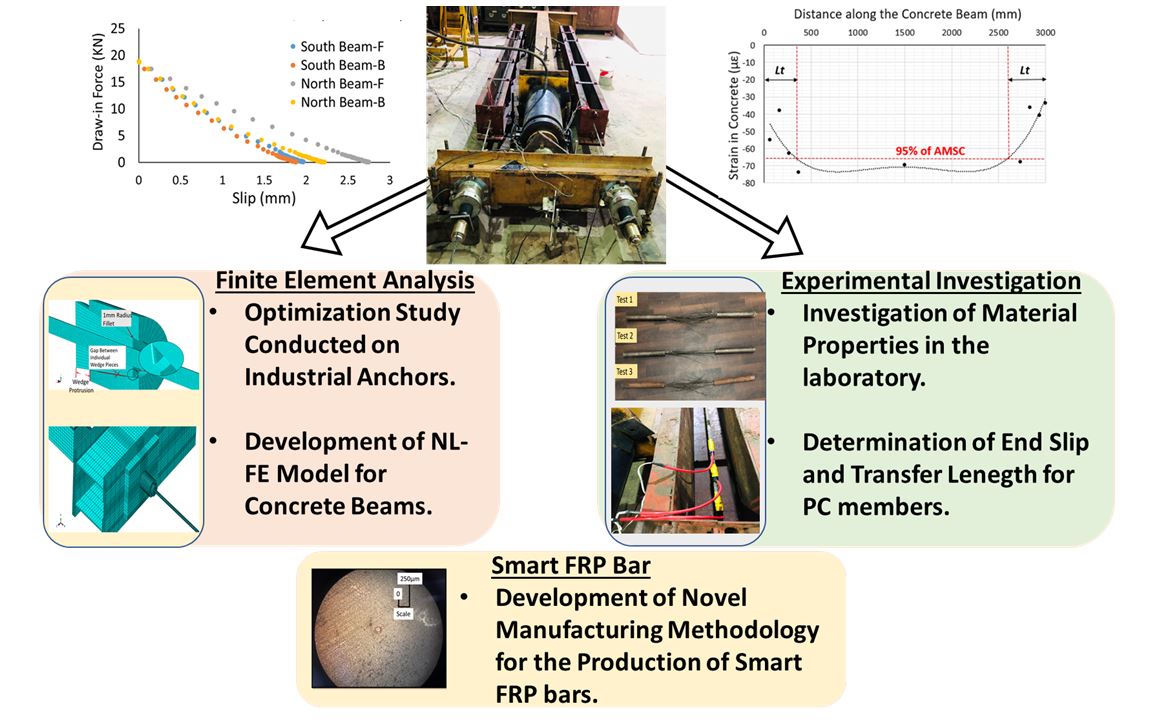Video Article Open Access
Application of Basalt Fiber Reinforced Polymer (BFRP) Bars for Prestressing Concrete Members
Arghadeep Laskar
Indian Institute of Technology Bombay (IITB), Mumbai 400076, India
Vid. Proc. Adv. Mater., Volume 2, Article ID 2021-02144 (2021)
DOI: 10.5185/vpoam.2021.02144
Publication Date (Web): 07 Apr 2021
Copyright © IAAM
Graphical Abstract

Abstract
Prestressed concrete members have shown high durability by preventing cracking to minimize the penetration of water and air. However, even in case of prestressed concrete, corrosion of steel prestressing strand is inevitable which results in the degradation of the concrete structure and leads to excessive maintenance costs of the infrastructure. Non-metallic materials such as fiber reinforced polymer (FRP) pose attractive long-range potential because they are non-corrosive, light-weight and have a lower Young’s modulus than steel [1]. Very limited studies are available to adequately address the performance of newly developed organic basalt fiber reinforced polymer (BFRP) bars as prestressing element in prestressed concrete environments leading to its exclusion from the ACI-440.4R report [2] on prestressing concrete structures with FRP tendons. Thus, the current research presents an experimental and finite element investigation and introduces a new system of prestressing concrete members using BFRP bars as prestressing element in lieu of conventional steel prestressing strands. In the present study, firstly, the compatibility of two commercially available industrial wedge-anchors have been tested to pretension 8 mm and 12 mm BFRP bars obtained from two different suppliers. The wedge-anchor that performed well during the experimental investigation has been subsequently utilized to hold 8 mm BFRP bars in a test-setup while the bars are prestressed to 50% of its ultimate tensile capacity. The tests conducted on anchors showed an anchor‐efficiency between 59% and 79% and indicated that the tested anchors can pre‐stress the BFRP bars beyond the maximum initial pre‐stress limit defined for FRP tendons as per ACI-440.4R guidelines [2]. The measured loss due to stress‐relaxation of BFRP bars after 1000 h was measured as 12% and the data was extrapolated to predict million‐hour stress‐loss as 16%. The tests conducted on concrete beams prestressed with BFRP bars reported an approximate transfer length between 250 mm - 500 mm. The end-slips of the BFRP bars were in the range of 1.9 mm - 2.7 mm at the live-end and 1.6 mm - 2.2 mm at the dead-end of the concrete beam. The average bond-stress between concrete and BFRP bar lies between 1.8 MPa – 2.6 MPa (using concrete with 28 days characteristic cube strength of 40 MPa). Additionally, the combined strain loss over a period of 20 days due to the stress-relaxation of BFRP bars, elastic-shortening and shrinkage and creep of concrete beam has been found to be between 10% - 19% of the initial prestress value. Based on the experimental investigation, non-linear FE models have been developed for the wedge-anchor system and the prestressed concrete beam. Additionally, as part of a longer goal, the present research reports a novel manufacturing methodology for the embedment of fiber optic sensors inside a BFRP bar during the pultrusion process and subsequent recovery of the associated fiber-optic leads. The finished product has been developed by first calibrating the fiber optic sensors which are later embedded into the BFRP bars. Laboratory investigation have been reported for the developed smart BFRP prestressing bars to check its adequacy as compared to a normal prestressing BFRP bar.
Keywords
Basalt fibre reinforced polymer; fibre optic sensors; finite element analysis; prestressed concrete.
Acknowledgement
The authors would like to acknowledge the Commonwealth Scholarship Commission (CSC) in the UK for providing the essential funding to support a part of the present research work. The authors are also thankful to Miss Athena Luo, Export manager at Liuzhou QM Construction Machinery, Guangzi, China, Mr Valery Nikolaev, managing director at ZAORPP and Mr. Egor Litvinov, COO at Galen LLC, USA for providing requisite samples of industrial anchors and BFRP bars for this research.
References
- J. M. Lees and C. J. Burgoyne, “Transfer Bond Stresses Generated between FRP Tendons and Concrete,” Mag. Concr. Res., 1999, vol. 51, no. 4, pp. 229-239.
- ACI 440.4R, “Prestressing Concrete Structures with FRP Tendons,” ACI Comm., 2004, pp. 1-35.
Biography
Arghadeep Laskar is Assistant Professor in the Civil Engineering Department of IIT Bombay in India since 2014. Prior to that he worked as a Structural Engineer in the offshore industry in Houston for five years after completing his PhD at University of Houston. His primary research interests are in the area of large-scale tests and FE simulation of concrete structures. Currently also working on investigating the possibility of using BFRP bars for prestressing concrete structures.
Video Proceedings of Advanced Materials

Upcoming Congress



